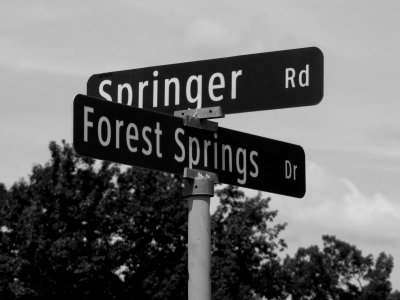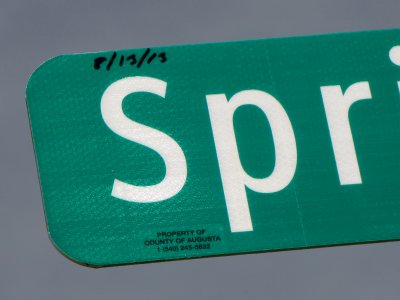Two near-identical photo features…
5 minute read
September 2, 2013, 11:54 PM
As of this writing, the photo feature shows a street sign marking the intersection of Forest Springs Drive and Springer Road in Stuarts Draft, taken on August 25:
If this setting looks familiar, I’m not surprised. The exact same setting ran as the photo feature three weeks prior, on August 11:
What’s the difference? Besides the foliage on the trees, the street signs were changed. Funny how it all happened, though. I took the earlier photo on March 25 when I was doing some photography of the snow in the neighborhood where my parents live. I readily admit that when I took the photos of the street signs, I had the Main Page in mind. The photo I ended up picking showed the street sign from the southeast. It also picked up an error that had gone unnoticed for nearly two decades: the suffix on the Forest Springs Drive sign was wrong. I was surprised that I had never noticed this before. I usually notice these sorts of things. Turns out that there was a good reason for this: only one side of the sign was in error. This is the alternate version that didn’t get used, which showed the other side:
Turns out that the side that I would always see was correct. Strange how that happens. This sign was put up in the 1990s, and was part of a large signage project that was completed throughout Augusta County from 1992-1995 (give or take on the end date) to improve the ability of emergency responders to locate incidents. With this project, every road in the county was given a name, rather than, in many cases, just a route number. The final stage of the project, completed in 1999-2000, gave every structure in the county a street address that corresponded to the new street names (called “911 addresses” at the time). The new house numbers were allocated according to a formula relating to what side of the road you were on and distance from a zero point on the road. No longer would the house numbers go up a digit just because you were on the next block. As an example, a house formerly numbered 625 was renumbered 386 under the new system. That also eliminated the old rural route addresses on some houses that were “Route X, Box Y” and gave them real street addresses for the first time.
I don’t profess to know how street signs were manufactured in the mid 1990s when the county updated all of the street signs. Looking carefully at the color photo, you may notice that a few letters are slightly off in their placement. The “E” in “Forest” is tilted slightly forward, and the “R” in “DR” is similarly tilted forward. It would appear that the letters in the old signs were stickers, placed over a solid green background. Was the placement of these letters done manually, using guides to ensure proper layout? Considering the imperfections noted, I’m thinking that might have been the case. And if that’s the case, it seems likely that the person who laid out the sign back in the mid 1990s accidentally transposed two letters. It happens.
Funny, though, that no one noticed it until I was prepping the photo for Schumin Web. My father didn’t even realize it when I was telling him about it on the phone. He actually went outside to look at it while I was still on the phone, and there it was: right on one side, wrong on the other.
However, the moral of the story is that if you spot an error or a problem with a permanent sign on a road, be it a street sign, a guide sign, a warning sign, etc., it’s always a good idea to contact the entity responsible for sign maintenance in your jurisdiction. In Virginia, the responsibility is split between the local jurisdiction and the state. The local jurisdiction (Augusta County, in this case) maintains the street signs. The state (through VDOT) maintains all other signage. This goes back to what I’ve said before about contacting Metro customer service:
There is no magic mechanism that tells Metro when something is not functioning correctly. Someone must tell them so that they will know to fix it. Thus we, the riders, are another set of eyes and ears noticing when there are problems that need to be addressed.
This obviously isn’t about Metro, but the point still holds. It’s often up to us to be the eyes and ears for public agencies, and tell them when something needs maintenance, just like one would tell a landlord about a leaky faucet, because they can’t be everywhere all the time.
So I took my own advice and called this one in. I reported the problem with the sign and the location on August 12, the Monday after the original feature ran, and they responded quickly:
Note the handwritten date in the corner of the new Springer Road sign: 8/13/13. That would seem to me that they made the new signs on the very next day after I reported them. Excellent. I don’t know when the county actually installed the new signs, but they were there when I came to visit on August 23. I was surprised to see that they replaced the Springer sign as well as the Forest Springs sign, though, since the Springer sign was correct. I assume that this was done because of newer standards for street signs that require a certain level of reflectivity for street signs, as well as mixed-case text.
It should also be noted that besides conforming to the new design standards (using Clearview!), it would appear as well that the new signs are manufactured differently than the older sign. This new sign would appear to be printed vs. laid out manually, as the reflectors in the sign all line up on the boundaries between the letters and the background (they didn’t before).
So kudos to Augusta County for fixing the sign. And don’t forget that if you see a sign or traffic control device that is in error, damaged, requires maintenance, or otherwise needs attention, you need to call the entity responsible for maintaining that sign to let them know. Google is your friend when it comes to finding out what that entity is. I googled it to find out who it was for Augusta County. Trust me, highway departments, like other entities, don’t want things to be wrong that is in their jurisdiction. They also want to know when something is wrong so that they can fix it.
Categories: Roads, Schumin Web meta, Stuarts Draft













